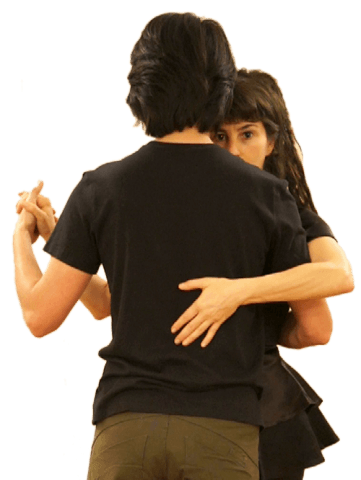The first time I felt it was in Sydney. I was dancing socially for the first time with one of my private students. He’d been training with me for about 6 months, and I was impressed by his physical skills and improvisation. There we were in a milonga, and he did this sequence: lateral step with right, change to left, back step with right. And he did it several times in the tanda. I was like “What is that? It’s terrible! Where did you learn that?”
 These days in Berlin 50% of Marks do this sequence within 5 seconds that my eye lands on them. (I spent a couple of weeks sitting with my stopwatch in the milonga checking my perceptions.) Another 35% do it under 30 seconds. That leaves just 15% of the dancers in the milonga who are not doing this sequence ad nauseum, and a chunk of these are beginners who are, appropriately, working on walking. Not very many of the 15% are advanced dancers who are doing something else. When you look at the dance floor at any milonga, you see this sequence constantly, in dancers of all levels except rank beginners. This level of tango repetitiveness is a danger sign for the health of our improvised dance.
These days in Berlin 50% of Marks do this sequence within 5 seconds that my eye lands on them. (I spent a couple of weeks sitting with my stopwatch in the milonga checking my perceptions.) Another 35% do it under 30 seconds. That leaves just 15% of the dancers in the milonga who are not doing this sequence ad nauseum, and a chunk of these are beginners who are, appropriately, working on walking. Not very many of the 15% are advanced dancers who are doing something else. When you look at the dance floor at any milonga, you see this sequence constantly, in dancers of all levels except rank beginners. This level of tango repetitiveness is a danger sign for the health of our improvised dance.
No matter how attracted I am to a Mark’s taste in pants, if he does this sequence twice before getting out of my sight in the ronda, I’m already over him.
The thing is, there are sequences which have some merit, and sequences which are dull and lazy. The cross has merit because it’s beautiful, iconic, and can offer a lot of musical possibilities. Ocho cortado has charm and contrast and lends itself to a variety of dynamics. But The Evil Sequence is not beautiful, rarely feels good because of prevalent bad technique on the mark’s backstep, and is almost always done with the same musicality (quick-quick-slow).
When “rhythmic” dancing first came into vogue roundabout 2010, there was in Buenos Aires a very popular “quick-quick-slow” sequence: viborita (molinete lineal with the side step accelerated and truncated to just a change of foot) with a change of pattern, so you get back-change-back or front-change-front. This was interesting, and exciting. The Revel had to stay alert to the difference between the standard molinete lineal and the modification, and to the speed. The mark for the change of foot had to be well-distinguished from rebote cadera. The sequence could be repeated (requiring more alertness). And the mark might not mirror the movement, but take only two steps in parallel with her line. Best of all, the acceleration of the sequence lended itself to hot endings, like contra voleo or sacada, but only if the revel was sharp enough not to get lulled into the pattern, and able to keep her free leg free and ready. Now this is a sequence worth dancing, and which can be used multiple times in the same song, because it challenges the dancers and offers possibilities for variation and growth, while also providing an easy way to speed up and slow down in the basic quick-quick-slow rhythm. Moreover this is a sequence which can stand alone, but also creates power for some kind of crescendo to follow. The Evil Sequence is a short, dead sentence. It doesn’t invite the next movement. It’s like saying, “well the weather is fine” several times a minute.
Personally I’m embarrassed when I mark any sequence twice in a single song. But any mark who is dancing this same sequence throughout a song or an evening should really check himself and spend some time studying the rich vocabulary available for this beautiful, historic dance.
But dullness is not the same as evil, and I don’t use this term casually.
What makes it evil is the damage it is doing to our entire community. If we are to dance well, we need Revels who are paying attention, whose senses are sharp and bodies are ready for anything. When a whole community is repeating the same sequence tens of times in every song, all night, every night, everywhere, we create habits in the Revels’ bodies which are hard for them to break and which then put the Marks into a prison which we cannot escape.
Just try marking it in reverse, and see how many girls force a second change of foot because their bodies are totally disbelieving in the possibility of stepping front with their RIGHT foot. This is evidence that their sensitivity has been damaged.














